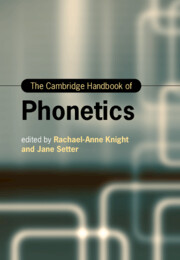Book contents
- The Cambridge Handbook of Phonetics
- Cambridge Handbooks in Language and Linguistics
- The Cambridge Handbook of Phonetics
- Copyright page
- Contents
- Figures
- Tables
- Contributors
- Introduction
- Section I Segmental Production
- Section II Prosodic Production
- 6 Stress and Rhythm
- 7 Lexical Tone
- 8 Intonation
- 9 Voice Quality
- Section III Measuring Speech
- Section IV Audition and Perception
- Section V Applications of Phonetics
- Index
- References
8 - Intonation
from Section II - Prosodic Production
Published online by Cambridge University Press: 11 November 2021
- The Cambridge Handbook of Phonetics
- Cambridge Handbooks in Language and Linguistics
- The Cambridge Handbook of Phonetics
- Copyright page
- Contents
- Figures
- Tables
- Contributors
- Introduction
- Section I Segmental Production
- Section II Prosodic Production
- 6 Stress and Rhythm
- 7 Lexical Tone
- 8 Intonation
- 9 Voice Quality
- Section III Measuring Speech
- Section IV Audition and Perception
- Section V Applications of Phonetics
- Index
- References
Summary
This chapter gives an overview of critical issues in contemporary research on the phonetics of intonation, arising from a survey of historical and recent trends in the field. We begin with a brief introduction to some of the key concepts to be used in the description of intonation in the chapter, which is based primarily on the Autosegmental Metrical framework. In the subsequent historical overview, we place this tone-based framework in its historical context, comparing it with the British tune-based tradition, before outlining more recent developments arising out of studies of typological variation of intonation, which have influenced our understanding of both the forms and the meanings of intonation. Three critical issues in the study of intonation are then reviewed: defining the phonetic variables of intonation, the relationship of intonation to other linguistic structures, and intonational variation and change. A sampling of recent research subsequently highlights work that relates to these critical issues. Key considerations for the teaching of intonation are then reviewed, before some closing comments on future directions for intonation research.
Keywords
- Type
- Chapter
- Information
- The Cambridge Handbook of Phonetics , pp. 209 - 236Publisher: Cambridge University PressPrint publication year: 2021
References
8.7 References
- 1
- Cited by



